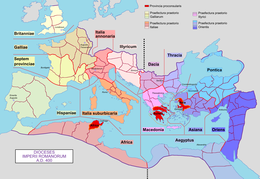Vicarius
Politics of ancient Rome |
|---|
 |
| Periods |
|
| Constitution |
| Political institutions |
| Assemblies |
|
| Ordinary magistrates |
| Extraordinary magistrates |
| Public law |
| Senatus consultum ultimum |
| Titles and honours |


Vicarius is a Latin word, meaning substitute or deputy. It is the root of the English word "vicar".
History
Originally, in
genitive (e.g. vicarius praetoris). At a low level of society, the slave of a slave, possibly hired out to raise money to buy manumission, was a servus vicarius.[1]
Later, in the 290s, Emperor
Roman provinces increased, and the creation of a new administrative level, the diocese. The dioceses, initially twelve, grouped several provinces, each with its own governor. The dioceses were headed by a vicarius, or, more properly, by a vices agens praefecti praetorio ("deputy of the praetorian prefect"). An exception was the Diocese of the East, which was headed by a comes
("count"). In 370 or 381, Egypt and Cyrenaica were detached from the Diocese of the East and made a diocese under an official called the Augustal Prefect.
In the eastern parts of the Empire, dominated by the Greek language and common use of Greek terminology, a vicarius was called an exarch.[2]
According to the officium, was rather similar to a gubernatorial officium. For example, in the diocese of Hispania, the staff of the vicarius included:
- The sestercesa year - the highest regular pay grade in the Roman civil service; the highest officials, governors and above, were not civil service).
- A cornicularius("chief of staff").
- Two numerarii (chief accountants).
- A commentariensis ("keeper of the commentary", the official diary).
- An adiutor (adjutant; literally "helper", an assistant).
- An ab actis ("acts-keeper", archivist).
- A cura epistolarum ("curator of correspondence").
- An unnamed number of subadiuvae ("deputy assistants").
- Various exceptores (lower clerks).
- Singulares et reliquum officium (various menial staff).
References
- doi:10.2307/298657.
- ^ Meyendorff 1989.
Sources
- Ostrogorsky, George (1956). History of the Byzantine State. Oxford: Basil Blackwell.
- ISBN 9780881410563.
- Notitia Dignitatum[full citation needed]
- Pauly-Wissowa (in German)[full citation needed]
